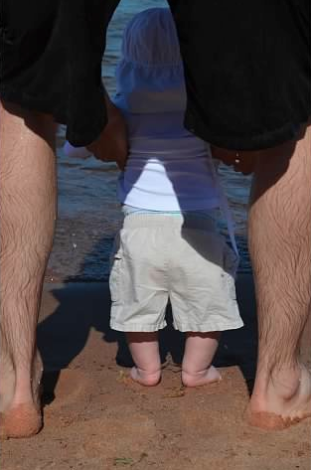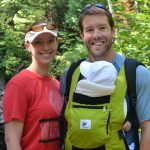Baby Steps = Healthy Knees
- Blog Baby Steps = Healthy Knees
 What can we learn from our children when hiking? Baby steps. Especially when knees are involved. They are some of our greatest assetts when hiking and so we need to take precautions to protect them.
Our knees are incredibly designed, able to withstand enormous amounts of pressure and maintain mobility and stability all at once. Even though it’s a hinge joint (like a hinge on a door), its complex movements involve bends, glides and twists. Our knees gain stability from numerous ligaments, including the infamous ACL, muscles and many other body structures (think your calf muscles and meniscus). All of these structures work together to keep you stable and moving on the trail and elsewhere.
When wearing a pack (and/or a child) the force on our knees increases by three to six times our body weight (including said child and pack). Add going downhill or stairs, as we did at Silver Falls, and the force on our knees increases even more! Sometimes we can get into trouble and have pain or dysfunction in our knees for a variety of reasons including, but not limited to: weakness around the knee (or above or below), general instability or overloading. In an effort to help, I put together some tips for protecting your knees while hiking.
Here are six tips for reducing impact on your knees (and other areas) when hiking:
Consider Poles
Personally I like having my hands free when hiking so I have yet to convert to the pole carrying lifestyle, but properly adjusted hiking poles can do wonders on downhill and uneven terrain. Poles reduce the shock on your knees by redistributing some of the pressure to your arms. They also improve your stability on uneven terrain (or even terrain if you’re a klutz like me). There are several videos available on YouTube on how to properly adjust your poles.
Invest in Good Shoes
Ladies, proper support is not just for your girls; your dogs need help, too! Proper fitting hiking boots/shoes can assist your body in managing shock and give a bit of extra support as well. Well supported feet and ankles make for better supported knees. (Side note: if you have frequently sprained ankles, please consider seeing a physical therapist for a few visits. They can help create a custom plan for both strengthening and retraining your body to prevent future sprains.)
Carry Wisely
Carry your child properly in a good fitting pack. Keep them close, adjust the pack to fit you best and make sure the weight is distributed evenly side-to-side. A pack with a frame and a good hip belt will help in this area.
Become a Beefcake (aka stretch and strengthen your legs and core)
Earlier, I commented that good shoes will help support your knees. Strong, well-balanced muscles help as well! Hiking is great exercise, but please consider a strengthening program that involves weights (or body weight and children) and stretching after your exercise. Strong muscles are your natural “knee brace”.
Take Baby Steps (i.e. short steps downhill)
Don’t lock your knees when going downhill or take especially large steps. Small, baby steps about the length of your foot will decrease the pressure on your knees. I find that if I think of sitting back a little, this technique saves my knees and allows me to move a little faster. Don’t be afraid to experiment to find what feels best for you.
Zig Zag
Make your own switchbacks on steep terrain. I’ve had to do this several times, especially on rutted trails. You may feel silly, but trust me; you’ll want to keep doing it. Bob-n-weave with the best of them.
I hope this helps! Please visit moveforwardpt.com for more tips and tricks, including how to set up your nursery, returning to exercise, tips for tummy time, where to find a PT, and more.
Happy Hiking,
Jen, PT, DPT, GCS
What can we learn from our children when hiking? Baby steps. Especially when knees are involved. They are some of our greatest assetts when hiking and so we need to take precautions to protect them.
Our knees are incredibly designed, able to withstand enormous amounts of pressure and maintain mobility and stability all at once. Even though it’s a hinge joint (like a hinge on a door), its complex movements involve bends, glides and twists. Our knees gain stability from numerous ligaments, including the infamous ACL, muscles and many other body structures (think your calf muscles and meniscus). All of these structures work together to keep you stable and moving on the trail and elsewhere.
When wearing a pack (and/or a child) the force on our knees increases by three to six times our body weight (including said child and pack). Add going downhill or stairs, as we did at Silver Falls, and the force on our knees increases even more! Sometimes we can get into trouble and have pain or dysfunction in our knees for a variety of reasons including, but not limited to: weakness around the knee (or above or below), general instability or overloading. In an effort to help, I put together some tips for protecting your knees while hiking.
Here are six tips for reducing impact on your knees (and other areas) when hiking:
Consider Poles
Personally I like having my hands free when hiking so I have yet to convert to the pole carrying lifestyle, but properly adjusted hiking poles can do wonders on downhill and uneven terrain. Poles reduce the shock on your knees by redistributing some of the pressure to your arms. They also improve your stability on uneven terrain (or even terrain if you’re a klutz like me). There are several videos available on YouTube on how to properly adjust your poles.
Invest in Good Shoes
Ladies, proper support is not just for your girls; your dogs need help, too! Proper fitting hiking boots/shoes can assist your body in managing shock and give a bit of extra support as well. Well supported feet and ankles make for better supported knees. (Side note: if you have frequently sprained ankles, please consider seeing a physical therapist for a few visits. They can help create a custom plan for both strengthening and retraining your body to prevent future sprains.)
Carry Wisely
Carry your child properly in a good fitting pack. Keep them close, adjust the pack to fit you best and make sure the weight is distributed evenly side-to-side. A pack with a frame and a good hip belt will help in this area.
Become a Beefcake (aka stretch and strengthen your legs and core)
Earlier, I commented that good shoes will help support your knees. Strong, well-balanced muscles help as well! Hiking is great exercise, but please consider a strengthening program that involves weights (or body weight and children) and stretching after your exercise. Strong muscles are your natural “knee brace”.
Take Baby Steps (i.e. short steps downhill)
Don’t lock your knees when going downhill or take especially large steps. Small, baby steps about the length of your foot will decrease the pressure on your knees. I find that if I think of sitting back a little, this technique saves my knees and allows me to move a little faster. Don’t be afraid to experiment to find what feels best for you.
Zig Zag
Make your own switchbacks on steep terrain. I’ve had to do this several times, especially on rutted trails. You may feel silly, but trust me; you’ll want to keep doing it. Bob-n-weave with the best of them.
I hope this helps! Please visit moveforwardpt.com for more tips and tricks, including how to set up your nursery, returning to exercise, tips for tummy time, where to find a PT, and more.
Happy Hiking,
Jen, PT, DPT, GCS
 Jen Stevens is a Doctor of Physical Therapy and a Board Certified Specialist in Geriatrics (surprise!). Currently, she is specializing in trucks, buses, cars, planes, mud, hiking and playing in water as she stays home with her two young boys.
Jen Stevens is a Doctor of Physical Therapy and a Board Certified Specialist in Geriatrics (surprise!). Currently, she is specializing in trucks, buses, cars, planes, mud, hiking and playing in water as she stays home with her two young boys.
This post is not intended to serve as personalized medical advice. Please seek the advice of a physical therapist or other medical practitioner if you are having pain or dysfunction.
Related Content




Comments